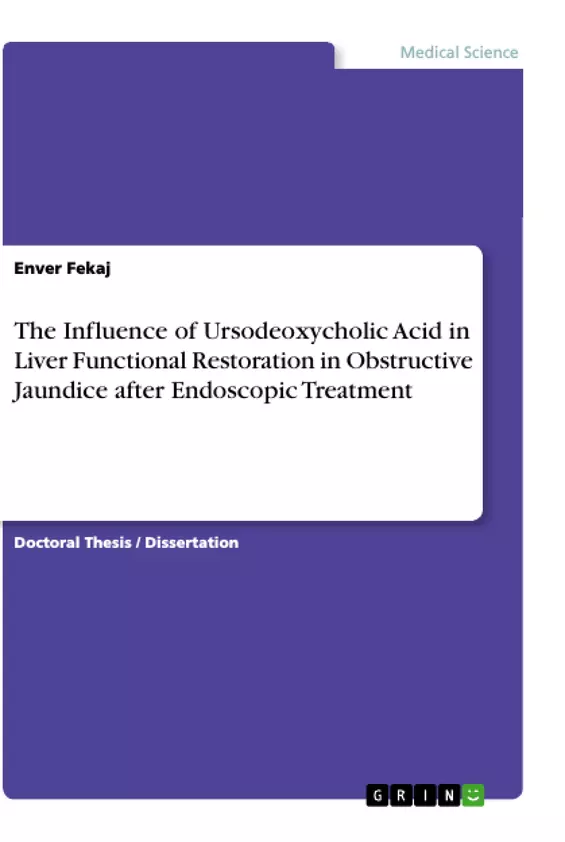The aim of this study is the evaluation of the effect of UDCA in liver functional restoration of patients with obstructive jaundice in the early period after endoscopic intervention. Specific aims consisted on the evaluation of the effect of UDCA in relation to etiology of obstructive jaundice, to gender, and to age of patients. The most common causes of obstructive jaundice are choledocholithiasis, strictures of the biliary tract, cholangiocarcinoma, carcinoma of pancreas, pancreatitis, parasites and primary sclerosing cholangitis. When mechanical biliary obstruction is diagnosed, surgical, endoscopic or radiologic intervention is usually recommended.
In this prospective, randomized, open-labeled, and controlled study, 62 patients were enrolled. After diagnosis, eligible patients with obstructive jaundice who met inclusion criteria were randomly divided in the investigation group, in which has been administered UDCA, and in the control group. UDCA administration started twenty-four hours after endoscopic treatment. It was administered at 750 mg/day, divided into three daily doses and lasted fourteen days. Serum-testing in patients with obstructive jaundice included determination of bilirubin (total and direct fractions), alanine transaminase (ALT), aspartate transaminase (AST), gama-glutamil transpeptidase (GGT), alkaline phosphatase (ALP), albumin, neutrophil/ lymphocyte ratio (N/L ratio), urea, glucose, and creatinine. These parameters were determined one day prior endoscopic intervention, and on the fifth, tenth, and fifteenth days after endoscopic intervention. The primary outcome measure in this study was bilirubin, alkaline phosphatase, and GGT serum levels decreasing rate. The secondary outcome was assessment liver functional parameters in which, treatment with UDCA, have had greater impact.
UDCA has accelerated reducing the level of total bilirubin, direct bilirubin, GGT, and neutrophil/lymphocyte ratio, but did not decrease the level of ALT, AST, and alkaline phosphatase, and did not induce increasing of albumin level. UDCA had greater impact on GGT than in other functional liver parameters. The effect of UDCA did not depend on the gender and the age of patients, but did depend on the etiology of obstructive jaundice. It was more effective in patients with choledocholithiasis than in patients with malign stenosis of biliary tree.
Inhaltsverzeichnis (Table of Contents)
- 1 BACKGROUND
- 1.1 Epidemiology
- 1.2 The diagnosis of obstructive jaundice
- 1.2.1 The clinical presentation
- 1.2.2 Laboratory findings
- 1.2.3 Imaging examination
- 1.2.3.1 Transabdominal sonography
- 1.2.3.2 Endoscopic sonography
- 1.2.3.3 Computed tomography
- 1.2.3.4 Magnetic Resonance Cholangiography (MRCP)
- 1.2.3.5 Endoscopic Retrograde Cholangiopancreatography (ERCP)
- 1.2.3.6 Percutaneous Transhepatic Cholangiopancreatography (PTC)
- 1.3 Differential diagnosis of jaundice
- 1.4 Obstructive jaundice- related complications
- 1.4.1 Intestinal permeability in obstructive jaundice
- 1.4.2 Hemostasis impairment in patients with obstructive jaundice
- 1.4.3 Obstructive jaundice and renal dysfunction
- 1.4.4 Obstructive jaundice and hepatic dysfunction
- 1.5 Treatment modalities
- 1.5.1 Endoscopic Retrograde Cholangiopancreatography (ERCP)
- 1.5.2 Surgical treatment
- 1.6 Ursodeoxycholic acid and its properties
- 1.6.1 Mechanisms of action of UDCA
- 1.6.1.1 Protection by UDCA against cell death induced by cytotoxic bile acids
- 1.6.1.2 Modulation of the expression of liver transporters and enzyme systems by UDCA
- 1.6.1.3 Modulation of cholangiocyte transport and ductular bile flow by UDCA
- 1.6.1.4 Immunosuppressive and anti-inflammatory properties of UDCA
- 2 AIMS AND PURPOSE OF THE RESEARCH
- 2.1 General aim
- 2.2 Specific aims
- 3 METHODS/DESIGN
- 3.1 Study objectives
- 3.2 Study design
- 3.2.1 ERCP procedure
- 3.2.2 Biochemical testing
- 3.2.3 Inclusion criteria
- 3.2.4 Exclusion criteria
- 3.2.5 UDCA administration
- 3.2.6 Power of the study
- 3.2.7 Data sources and search strategy
- 3.2.8 Outcomes
- 3.2.9 Randomization
- 3.2.10 Ethics
- 3.2.11 Data collection and statistical analysis
- 4 RESULTS
- 4.1 The effect of UDCA in relation to gender of patients
- 4.2 The effect of UDCA in relation to etiology of obstructive jaundice
- 4.3 The effect of UDCA in relation to age of patients
- 5 DISCUSSION
- 6 CONCLUSIONS
- 7 REFERENCES
Zielsetzung und Themenschwerpunkte (Objectives and Key Themes)
This PhD dissertation investigates the influence of ursodeoxycholic acid (UDCA) on liver functional restoration in patients with obstructive jaundice after endoscopic treatment. The study aims to assess the efficacy of UDCA in improving liver function and reducing complications associated with obstructive jaundice. Key themes explored include:- The diagnosis and treatment of obstructive jaundice
- The role of UDCA in liver function restoration
- The impact of UDCA on biochemical markers of liver function
- The potential benefits of UDCA in managing obstructive jaundice-related complications
- The effectiveness of UDCA in different patient subgroups based on gender, etiology, and age
Zusammenfassung der Kapitel (Chapter Summaries)
- Chapter 1: BACKGROUND provides an overview of obstructive jaundice, including its epidemiology, diagnosis, complications, and current treatment modalities. This chapter also explores the properties of UDCA and its mechanisms of action.
- Chapter 2: AIMS AND PURPOSE OF THE RESEARCH outlines the study's objectives and specific aims. The study intends to investigate the influence of UDCA on liver functional restoration in patients with obstructive jaundice after endoscopic treatment.
- Chapter 3: METHODS/DESIGN details the study design, including patient inclusion and exclusion criteria, UDCA administration, and data collection and analysis methods. The study employs a randomized controlled trial design.
- Chapter 4: RESULTS presents the findings of the study, analyzing the effect of UDCA on liver function parameters, such as liver enzymes and bilirubin levels, in relation to patient gender, etiology of obstructive jaundice, and age. The results provide evidence of the potential benefits of UDCA in improving liver function and reducing complications in patients with obstructive jaundice.
Schlüsselwörter (Keywords)
The dissertation focuses on obstructive jaundice, ursodeoxycholic acid (UDCA), liver function restoration, endoscopic treatment, biochemical markers, complications, patient subgroups, randomized controlled trial, and clinical efficacy. The research examines the potential therapeutic benefits of UDCA in improving liver function and managing complications associated with obstructive jaundice after endoscopic treatment.- Quote paper
- Enver Fekaj (Author), 2019, The Influence of Ursodeoxycholic Acid in Liver Functional Restoration in Obstructive Jaundice after Endoscopic Treatment, Munich, GRIN Verlag, https://www.grin.com/document/505328



